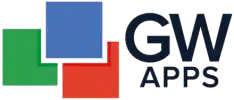
What's New...
We’re excited to share these feature enhancements that have been implemented to GW Apps over the past 90 days. We hope these updates will bring great value to your usage of our platform.
'Pages' Enhancements
We’re introducing a few major updates to ‘Pages’ with the addition of three new widgets. ‘Pages’ serve as the dashboards or landing pages for your apps, and these enhancements aim to improve both the functionality and user experience of them.
• New Bar/Line Chart Widget
A new reporting widget has been added to Pages. This widget allows users to visualize datasets in a Bar or Line style report, extending the reporting capabilities of your Pages. It includes a variety of customization options, including chart orientation, size, labels, and the ability to view data (on a Bar style report) side-by-side or stacked.

• New iFrame Widget
A new iFrame (inline frame) widget has been added to Pages, enabling App Designers to embed and display a web page directly on a Page. This widget aims to expand the functionality of Pages by enabling in-app access to outside resources, reports, and webpages. It includes a couple visual customization options and the ability to allow the iFrame to run Javascript.

• New YouTube Player Widget
App Designers now have the option to embed YouTube videos into Pages using the new YouTube Player widget. This feature also includes the ability to select timestamps for the start and end time of the embedded video.

Other Enhancements
We’ve also implemented several enhancements based on customer requests and feedback. These improvements touch on multiple aspects of GW Apps, enhancing not only the functionality but also the customizability of your applications.
• Attachment Previews Extended
We’ve added support for previewing additional attachment file types. Previously, only image attachments could be previewed in a window overlay by clicking on the attachment. This feature has been extended to include PDFs, .csv files, and Word Docs.
• Additional API Options for Records
Two new API options have been added: Update Record Attachment, and Delete Record Attachment. These options allow APIs to update or delete files attached to Attachment Fields on a record.
• Sort & Filter Views by Undisplayed Fields
Views can now be sorted and filtered by fields that are not displayed in the view. For example, a View that does not display the ‘Created On’ date field can still be sorted by the ‘Created On’ date without surfacing the data to app users.
• Field-Based Earliest/Latest Allowed Date Validation
Date Field validation options have been extended to include field-based earliest and latest allowed dates, meaning the earliest and latest allowed date validation can be dynamically determined by another field. For example, an ‘End Date’ field can have its ‘Earliest Allowed Date’ be determined by a ‘Start Date’ field, ensuring the ‘End Date’ cannot be before the ‘Start Date.’
• Additional Filtering Operators for Record ID
Two new Operators have been added to ‘Record ID’ filtering. Previously, when filtering by Record ID, the only available Operator was ‘equals.’ We’ve now added ‘not equals’ and ‘like’ Operators. This update opens up additional filtering functionality by offering more ways to leverage the unique ID of each record. This modification is applicable in all instances where filtering is offered, including Views, Triggers, and Actions.
• New Formatting Options for Field Data in Emails, PDFs, and Word Docs
Support for custom formatting of Date and Time Field Data used in Email, PDF, and Word Doc templates has been added. When creating these templates, additional formatting syntax can be appended to the end of the field short-codes to modify the format of the displayed Field Data.
For example, a Date Field with the short-code ${datefield1} can be altered to display the date in ‘MM/yy’ format using the following syntax: ${datefield1 | dateFormat: ‘MM/yy’}.
